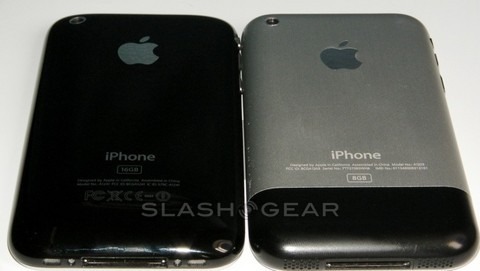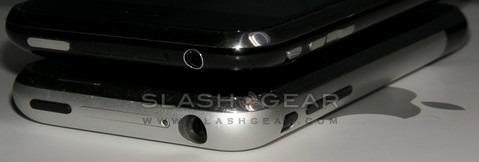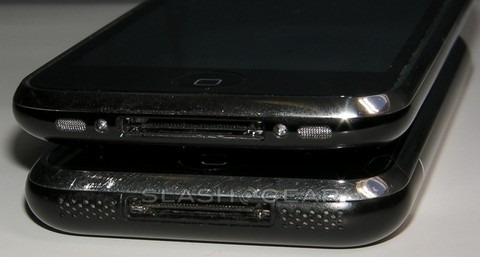SlashGear iPhone 3G Review
It hardly seems like a year since the first-gen iPhone stormed the cellphone market, grabbing Apple a coveted spot in the top ranks of handset manufacturers and redefining the sort of usability people could expect from a touchscreen device. Now, however, the iPhone gets its first significant upgrade; you'd have to have been hiding under a rock to have missed the news that Apple have added both 3G and GPS to the handset – if you were, check out our WWDC 2008 keynote coverage – as well as dropping the entry price to just $199. The iPhone 3G launched this morning, and we were there bright and early to cover the event of a new cellphone.
The change isn't just 3G and navigation, however – it's coincided with a software refresh and the launch, finally, of officially-sanctioned third-party software courtesy of the Apple App Store. There's also a new plastic casing, which adds a little extra depth to the handset but disguises it well with tapered edges, and that more importantly presents far less of a barrier to all those wireless radios inside. When it was announced, Apple were keen to point out that the plastic would be reassuringly scratch-resistant; we're relatively impressed by how high-quality it feels, but given the fact that every plastic-bodied cellphone we've used, whether cased or otherwise, has ended up with at least some scratches, we reckon the iPhone will eventually go the same way.

In the hand, despite the swollen dimensions, the second-gen iPhone feels just as, if not more, svelte than its predecessor. The touchscreen display is unchanged and just as responsive, while the buttons have sharper edges and feel 'clickier' and more precise. There's no doubting that you've changed the volume, say. Even after a year for rivals to catch up, the OS X GUI is still a unique joy to use. Since the first iPhone we've seen challengers such as Sprint's Instinct, the HTC Touch Diamond and Sony Ericsson's XPERIA X1, and I can safely say that none are as intuitive as Apple's phone.

Fresh to the homescreen is the icon for the Apple App Store, which will eventually offer thousands of free and paid software titles that can be directly downloaded via 3G to the iPhone itself (assuming they're under 10MB; larger apps require WiFi or a sync with iTunes). Hit the existing Maps icon and you can take advantage of the GPS; there are no turn-by-turn instructions, nor voice-prompts, but it's more accurate than the original iPhone's pseudo-GPS which triangulated WiFi and cell towers. In fact the GPS is more useful elsewhere in the handset, particularly in geotagging photos (which added no noticeable lag to saving them).

One area which really needed polish was the iPhone's camera, and Apple have, frankly, dropped the ball here. Despite rivals offering 5-megapixels and beyond, the iPhone 3G has the same 2-megapixel shooter with no flash, no zoom and no video recording. It's still straightforward to use – as you might expect given the paucity of functionality – but it's no less frustrating given how suited the handset is to media. Elsewhere, sound quality through the speaker has been improved, both for music playback and calls, and the flush-fitting headphone jack is how it should have been in the first place.
3G data speeds, if you have a suitable connection, are a joy. The iPhone 3G whips through webpages, and while we're still collating the stats it looks to be anything from twice as fast to four times as fast as EDGE. All the more frustrating, then, when you walk out of AT&T's 3G coverage and find yourself languishing in the slow-lane; it's worth checking the carrier's coverage viewer to see if you'll ever be served with the high-speed goodness. WiFi works just as well as before, with the iPhone doing its best to avoid troubling you with network logons and the like.
With a new casing, you might've hoped that Apple would add a latch and let users replace the battery themselves. Sadly it's still a return-to-sender job, that the company will charge you $86 for. Again, that wouldn't be so much of an issue if 3G didn't chew through power quite as hungrily as it does; we're still testing, but early evidence suggests the handset will drain in half the time if you're keen with your surfing. Apple are quoting five hours of 3G, ten using EDGE; needless to say, you'll be charging the new iPhone every night.
Part of that is the fact that most iPhone 3G handsets will be taking on push email, with persistent connections to Exchange servers or Apple's MobileMe system thanks to the software update. This works just as demonstrated earlier on in the year; messages pop up straight away, and calendar synchronization is as slick.
You could make a strong argument, as an original iPhone owner, for sticking with what you've got. The new Firmware 2.0 software is already available from Apple, bringing the App Store and all the other non-hardware tweaks to the first handset, meaning the primary difference between it and the iPhone 3G is the GPS and 3G. If you were not quite seduced by the iPhone first time round, there's a fair chance the new iPhone 3G will work its magic on you; yes, there are flaws and omissions – the paltry Bluetooth support still rankles, as does the missing MMS messaging – but what the handset does well it does so well that you're less inclined to judge it harshly.
All in all, the iPhone 3G is part incremental, part significant update. Although out of the box the GPS may not be played to its best advantage, expect to see many third-party apps eking out new usage from it; similarly, the 3G data connection may suck up power but it finally gives mobile Safari the wings its talents deserve. Ironically, Safari itself is now the stumbling block; Apple are yet to introduce Flash support, meaning web video is still limited to the standalone YouTube app.
Finally, it would be remiss not to mention pricing. Apple are keen to advertise their lower prices; unfortunately, AT&T have somewhat soured the overall deal, having added an extra $10 to unlimited data rates and removed any free text messages. Over the course of a 24 month contract that's at least $240 extra for data alone, making the iPhone 3G actually more expensive than its predecessor. Only you can say whether it's worth it to you; all we'll say is that once you've surfed 3G on an iPhone, you'll not want to go back.
Is this another winner from Apple? Short answer: of course it is. The queues may be shorter than the first time around, but the consumer appetite is no less ravenous and the phone, overall, more satisfying. It's not perfect, of course, but we didn't expect it to be. What it is, though, is better -in general – than the competition. If you have specific needs – Bluetooth A2DP, for instance, a digital camera replacement or a hardware keyboard – then the iPhone 3G might not meet them. For most of the rest of us, it does just fine.

The iPhone 3G is available now, priced at $199 for the 8GB and $299 for the 16GB, both with a 24 month AT&T contract.
Related iPhone 3G reviews/first look and demo:iPhone 3G in the house!iPhone 3G hands-on by SlashGear JapaniPhone 3G versus first-gen iPhone








Click to view the rest of the iPhone 3G image gallery!
